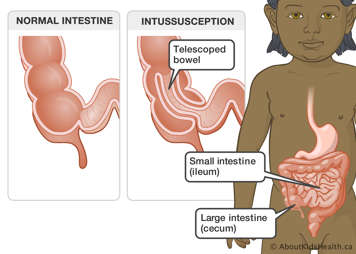What is intussusception?
Intussusception occurs when a part of the intestine folds into itself like a telescope, with one segment slipping inside another segment. This causes a blockage, preventing the passage of food through the intestine. When the "telescoped" section of the intestines is pressing on each other for a long period of time, it can cause irritation and swelling. This can cut off the blood supply to the intestines and cause serious damage.
Symptoms of intussusception may include:
- severe intermittent pain, that may present as a child bringing their knees to their chest.
- vomiting
- bloody and/or jelly-like stools
Intussusception between the small intestine and large intestine can occur in older infants and toddlers, most often occurring between the ages of five months and two years. Not all children have the above symptoms, so it is important that a health-care provider evaluates your child.
If your child's health-care provider thinks your child has intussusception, they will do a physical exam and history and order an abdominal ultrasound. Your child may need to have blood work completed.
Many cases of intussusception do not have an identified cause. Sometimes, there may be a lead point of the intussusception which may be identified by imaging or during surgery, if required. Other cases are thought to be due to viral or bacterial infections.

Treatment of intussusception
If your child has intussusception, the health-care team will decide on the best treatment plan for your child. This may include monitoring to see if the intussusception resolves on its own, an air or saline enema in the medical imaging (radiology) department and/or surgery.
Air/saline enema
An air/saline enema is performed in the medical imaging department by a radiologist. During the air/saline enema, a small, soft tube is placed in the rectum and air or saline is passed through it. The air or saline travels into the intestines and attempts to unfold the bowel that has "telescoped," fixing the intussusception. The radiologist may have to repeat the air/saline enema to be successful. Your child will remain in the emergency room for observation. If the health-care team decides an air/saline enema is not appropriate for your child, or the air/saline enema(s) are not successful, the intussusception can be treated with surgery.
What to bring to the hospital
Your child will already be staying in the hospital, so you do not need to bring anything on the day of the operation. But you may want to bring a toy that is special to your child. On the day they are released from the hospital, bring your child's car seat for the ride home.
Taking time off from work
It is difficult to plan how much time you will need to take off work. In most cases, however, you should be able to go back to work after about one week.
Before the surgery
Your child will not be allowed to eat or drink while under assessment for intussusception. This is especially important before surgery. Your child will have blood drawn and an intravenous (IV) inserted. The IV will keep your child hydrated. Also, the surgical team will ask you for consent regarding surgery and will go over the risks of the surgery.
During the surgery
Your child will be given a general anesthetic. This ensures that your child remains asleep through the surgery and prevents them from feeling any pain. Your child will also receive a dose of antibiotics through their IV before the surgery.
During the surgery, the surgeon will free the portion of the intestine that is telescoped and, if necessary, remove any of the intestinal tissue that has been damaged or caused this to happen. Depending on the situation, the operation may be done laparoscopically (using several small incisions) or open (using a larger incision).
The incision(s) will be closed using small pieces of tape called Steri-Strips or a surgical skin adhesive.
After the surgery
After the surgery, your child will go to the Post-Anesthetic Care Unit (PACU) or recovery room to wake up. You may visit your child once they wake up. Upon waking up, they will go to an inpatient unit.
Your child may have a tube in their nose that goes to the stomach, called a nasogastric (NG) tube, which will help keep their stomach empty while the bowels heal. Your child will receive pain medication through their IV after surgery to keep them comfortable. The surgical team will decide when it is appropriate for your child to begin eating following surgery. While they are not able to eat, they will receive hydration through the IV. We will encourage your child to get up and play or walk as soon as possible after surgery.
Bringing your child home
Your child can go home when:
- their heart rate, breathing, blood pressure and temperature are normal
- they are able to eat without vomiting (throwing up)
- they are comfortable taking oral (by mouth) pain medicine
Taking care of your child at home
Care of the incision
The incision(s) from the surgery will be covered by a dressing called Steri-Strips or surgical skin adhesive. You do not need to do anything to the Steri-Strips. A small amount of old blood on the Steri-Strips is common. If the blood seems fresh or the amount of blood increases, press on the area with a clean washcloth for five minutes. Then call your child's surgeon's office if it continues. If the bleeding does not stop, take your child to their health-care provider or to the nearest Emergency Department.
The Steri-Strips or surgical skin adhesive will fall off on their own. You may remove the Steri-Strips if they have not fallen off seven to 10 days after the surgery.
Activities
Your child can return to normal activities once they feel able. Discuss with your surgical team when they can return to sports and swimming.
Diet
Your child should be able to return to their normal diet after the surgery. If they have problems eating, call your surgeon's office.
Pain medicine
When your child comes home, you may want to give them acetaminophen or ibuprofen after surgery. Follow the instructions on the bottle for the amount of medicine to give them.
Bathing
You should give your child a shower or a sponge bath with non-scented soap and water 48 hours after surgery Wash the incisions gently. Avoid submerging the sites in a bath for two weeks following surgery.
Going back to daycare or school
Your child can return to daycare or school when they feel comfortable, and you are comfortable with them returning to their normal routine.
When to call the surgery team
After you have gone home you will need to watch for signs of infection and signs that intussusception has recurred (the intussusception has come back). The risk of recurrence depends on how it was treated. With non-operative management like an air or saline enema, the rate of recurrence is between two to seven per cent and is greatest within the first 48 hours following the intussusception being fixed. The risk of recurrence is much lower if a piece of intestine has been removed at the time of surgery.
Please call your child's surgeon's office if you see any signs of infection. These include:
- fever of 38°C (100.4°F) or higher
- redness around the incision
- drainage from the incision is yellow or green and has a foul smell
- swelling at the incision site
- increasing pain around the incision site
Please go to the Emergency Department if you see any signs of recurrence. These include:
- vomiting
- blood in the stool or stools that look like currant jelly
- abdominal pain
- fever of 38°C (100.4°F) or higher
- abdominal distension (a swollen tummy)
- irritability or difficulty settling
If you have a question or a concern that is not urgent, call your child's surgeon's office or the General Surgery Clinic during business hours or leave a message on the answering machine after hours. If you have an urgent concern, take your child to their health-care provider or the nearest Emergency Department.
